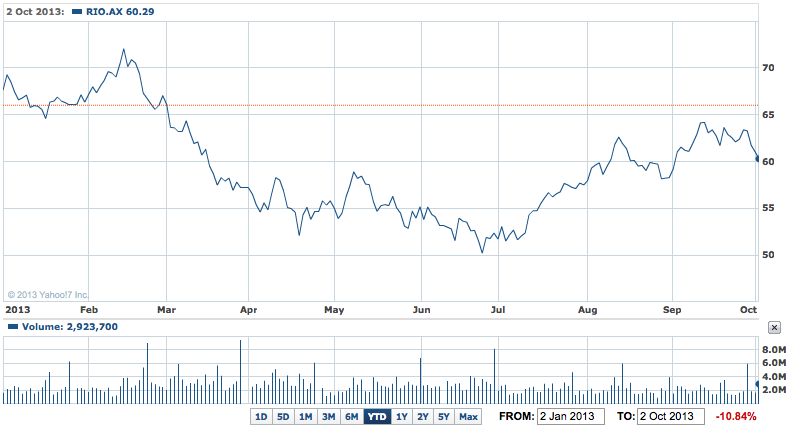Mining giant Rio Tinto (RIO) continues to make progress in its difficult talks with the Mongolian government on its hugely expensive Oyu Tolgoi copper and gold mine, and it’s also making rapid progress with work on its Pilbara iron ore expansion plan in Western Australia.
The market was unmoved by the news and the shares were down 84c or 1.4% at $60.23.
That was despite Rio saying yesterday that it had completed the first phase of the major expansion of its integrated iron ore operations in the Pilbara.
Western Australian Prermier Colin Barnett opened the company’s Cape Lambert Wharf B which will help bring the overall capacity of Rio Tinto’s Pilbara iron ore operations to 290 million tonnes a year (Mt/a), the largest iron ore operation in Australia and the second largest in the world.
Rio Tinto’s iron ore chief executive Andrew Harding said in a statement that “The 290 expansion, the largest integrated mining project in Australia, has created the opportunity for Rio Tinto to deliver superior value to shareholders and customers. It is testament to our focus on value-driven growth at our low-cost operations.
“We have again demonstrated our project execution performance is second to none, delivering this expansion ahead of schedule and under budget. This disciplined approach has generated greater value through capital expenditure savings of US$400 million (100% basis), achieved mainly from our engineering and contracting strategies across this phase of the programme.
“By running Australia’s lowest-cost iron ore operations we will ensure the benefits continue to flow through to the bottom line.”
The first shipment happened in late August and the ramp-up schedule is on track to reach a full run-rate by the end of the first half of 2014.
The second phase expansion of the port, rail and power infrastructure to 360 million tonnes a year is underway.
Rio said a number of options for mine capacity growth are under evaluation including incremental tonnes from low-cost productivity improvements, expansion of existing mines and the potential development of new mines.
That seems to indicate that the next expansion phase will not be rushed and that could increase slowly to match rising demand, which would require less capital investment.
RIO YTD – Official opening of new facilities at Cape Lambert fails to spur shares

Rio and the Mongolian government held an Oyu Tolgoi board meeting last week in London in which they resolved 15 out of the 30 urgent issues that had led to the suspension of the $US5.1 billion expansion project part of the project which has already cost billions of dollars.
Included in the agreement were the touchy issues of ownership of the relevant licences with all Oyu Tolgoi licenses owned by third parties to be transferred to Oyu Tolgoi so that the Mongolian government will own a 34% stake over the entire licensed Oyu Tolgoi deposit area.
This means that two licenses part-owned by Canada-listed mining company Entree Gold Ltd will be transferred to Oyu Tolgoi. As part of the transfer, the Mongolian government will receive an additional $US1.4 billion over the duration of the project.
Dow Jones, which reported the latest agreement, said that Rio had refused to comment. That’s not surprising given the touchy relations between the miner and the government on questions surrounding ownership of all the leases at the project, exports approvals and other lesser issues. The two parties signed an agreement back in 2009 that saw work start on the massive project’s first stage open cut mine.
Several months ago Rio halted work on the underground part of the project and laid off around 1,700 workers after the government demanded the country’s parliament had to first approve the financing of the second phase.
The Oyu Tolgoi project is 66% owned by Canada-based Turquoise Hill Resources which in turn is majority owned by Rio. The Mongolian government owns the remaining 34% stake in the mine.
Dow Jones said the next board meeting will be held on Monday to discuss cost overrun issues and the financing plan for the second phase.
At full output, Oyu Tolgoi will produce around 450,000 metric tonnes of copper and 330,000 ounces of gold a year, as well as silver and molybdenum.













